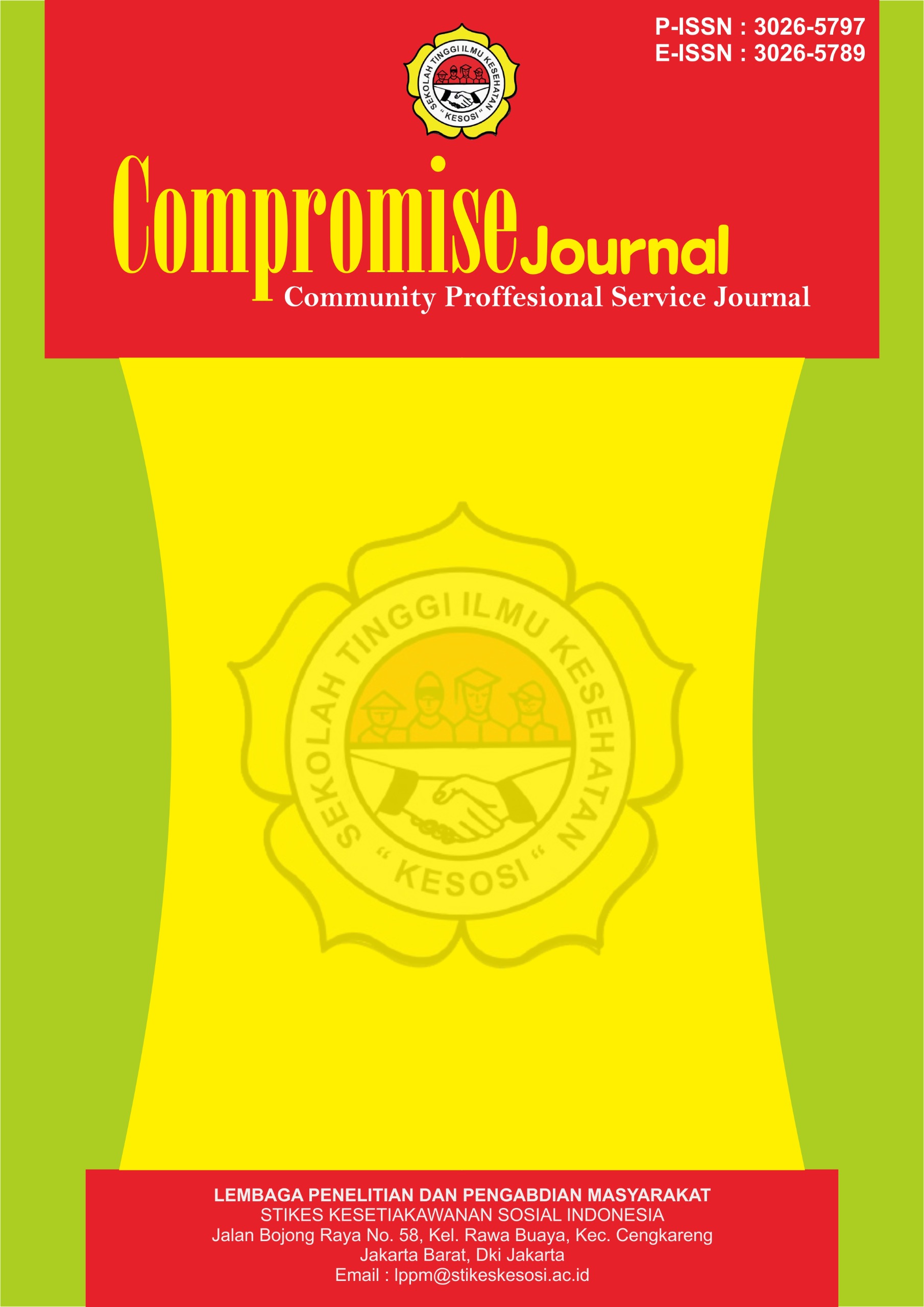Hubungan Kadar HB dengan Perdarahan Postpartum di Rumah Sakit Umum Daerah Djasamen Saragih Tahun 2023
DOI:
https://doi.org/10.57213/compromisejournal.v1i4.49Keywords:
HB Levels, Postpartum BleedingAbstract
According to the WHO (World Health Organization), every day in 2017 around 810 women died, at the end of the year reaching 295,000 people, of which 94% were in developing countries (WHO, 2019). The MDGs (Millennium Development Goals) which ended in 2015, were then continued with the development of the SDGs (Sustainability Development Goals) until 2030. The five biggest causes of maternal death in Indonesia in 2010-2016 were bleeding (30.3%), hypertension in pregnancy ( 27.1%), infection (7.3%), prolonged labor (1.8%), abortion (1.6%) and others (31.9%). This study aims to identify the relationship between HB levels and postpartum hemorrhage at the Djasamen Saragih Regional General Hospital in 2023.Type of quantitative research with a case control design. This study was conducted on a sample of 100 postpartum. To measure the characteristics of the respondents, a data collection form was used which was obtained through collecting data from the evaluation section at the Djasamen Saragih Regional General Hospital in 2023.Based on the statistical test using chi-square, the value of ρ = 0.001 (ρ <α, α = 0.05) is obtained, the strength of the relationship between the two variables is seen based on the contingency coefficient, which is 0.302, which means the strength of the relationship is moderate. Then the odds ratio (OR) results obtained OR = 0.215 [95% CI 0.087 – 0.532] which means that the range 0.087 – 0.532 does not exceed the value of 1, so postpartum mothers with low Hb levels during pregnancy have a greater chance of postpartum hemorrhage 0.215 than mothers postpartum Hb was normal during her pregnancy.There is a relationship between Hb levels and postpartum hemorrhage at the Djasamen Saragih Regional General Hospital in 2023
References
Affandi (2015). Buku Panduan Praktis Pelayanan Kontrasepsi. Edisi 3. Jakartta. PT. Bina Pustaka Sarwono Prawirohardjo
Bergmann, R.L (2012). Prevalence and Risk factors for Early Postpatum Anemia. Eur. J. Obstet. Gynecol.
Cunningham, F.G (2015). Obstetri Williams. Edisi 21. Jakarta: EGC
Departemen Kesehatan Republik Indonesia (2019). Profil Kesehatan Indonesia.
Dorland, W.A (2011). Kamus Saku Kedokteran Dorland. EGC. Jakarta
Faisal, A (2018). Perdarahan Postpartum. Diunduh dari http://www.infokess.com pada tanggal 8 Maret 2022
Garrido, C, M (2017). Maternal Anemia After Delivery: Prevalence and Risk Faktor Maternal Anemia After Delivery: Prevalence and Risk Factors. J. Obstet. Gynaecol (Lahore)
Kementerian Kesehatan RI (2013). Buku Saku Pelayanan Kesehatan ibu di Fasilitas Kesehatan Dasa dan Rujukan
Lestari, G. I. (2014). Analisis Hubungan Anemia dengan Perdarahan Postpartum di RSUD Jenderal Ahmad Yani Kota Metro Tahun 2013, Jurnal Kesehatan Metro Sai Wawai, Vol. VII No. 2, p. 69
Manuaba (2013). Ilmu Kebidanan, Penyakit Kandungan dan KB. EGC. Jakarta
Maritalia, Dewi (2012). Asuhan Kebidanan Nifas dan Menyusui. Yogyakarta: Pustaka Pelajar
Mochtar (2014). Sinopsis Obstetri. Jakarta: EGC
Prawirohardjo, S (2016). Ilmu Kebidanan. Bina Pustaka. Jakarta
Rohan Yassin (2018). Hubungan Anemia dengan Kejadian Perdarahan Postpartum di RSUD H. Padjona Dg. Ngalle Kabupaten Takalar. Jurnal Ilmiah Forilkesuit Volume 1 No 2 Agustus 2019.
Rukiyah, Ai, Y. Lia (2014). Asuhan Kebidanan Patoloi IV (patoloi Kebidanan). Jakarta: Trans Ino Media
Saleha, S (2014). Asuhan Kebidanan Pada Masa Nifas. Jakarta: Salemba Medika
Saifuddin (2012). Buku Panduan Praktis Pelayanan Kesehatan Maternal dan Neonatal. Jakarta: Yayasan Bina Pustaka Sarwono Prawiroharjo
Sebghati, M and Chandraharan (2017). An Update on the Risk Factors for and Managemen of Obstetric Haemorrhage, Women’s Health, Vol 13. No. 2
Sentilhes, L, Merlot B (2016). Postpartum Haemorhage, Prevention and Treatment, Expert Review of Hematology. Taylor & Francis. Vo. 9 No. 11
Sherwood, L (2014). Fisiologi Manusia Dari Sel Ke Sistem. EGC. Jakarta
Ummah dkk, (2018). Factor Resiko Penyebab Perdarahan Postpartm di Puskesmas Pamotan Kabupaten Rembang
WHO (2013). Haemoglobin Concentrations for the Diagnosis o Anemia and Assessmen off Severity, Mineral Nutrition Inormation System
William (2015). Obstetri Ginekologi. Jakarta: Buku Kedokteran EGC






